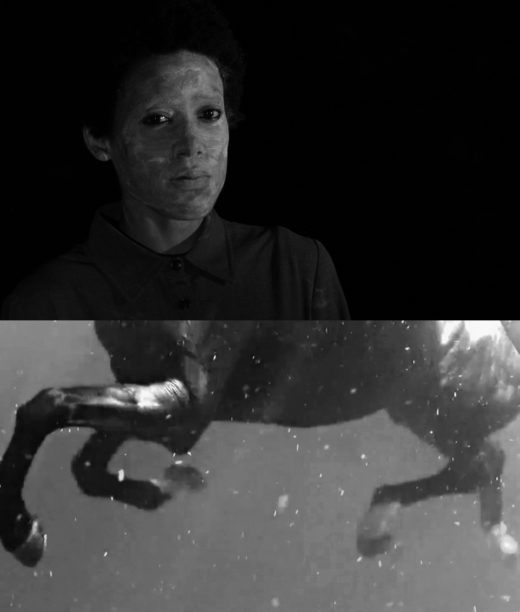Jamilah Sabur: My Queen before you go tell my horse
Veronica Mills

Jamilah Sabur, My Queen before you go tell my horse, Maggie Knox, June 25, 2016. Photo: Courtesy the artist
Maggie Knox
June 25, 2016
A robed figure emerges from the shadows atop a wooden staircase littered with flickering candles. Heavy notes of otherworldly music accompany the figure’s descent down the stairs. Coming to rest before a rapt audience, the candlelight reveals the white clay–painted face of artist Jamilah Sabur. Sabur’s My Queen before you go tell my horse, an installment of a larger series, responds to the dysfunctional global mechanisms that helped create the noxious breeding ground for Jamaica’s looming economic and environmental crises.
Performing as a traditional Obeah priestess, Sabur summons the spirit of Michael Manley, the late former prime minister of Jamaica. Manley was a globally recognized revolutionary figure, a leader in the fight against economic inequality across the developing country. In Sabur’s work, Manley addresses the International Monetary Fund (IMF) and the World Bank. Looped images of Manley play on a large monitor above Sabur’s head. Her electronically manipulated voice echoes inside the intimate performance space, further intensifying the surreal and mystical nature of the “conjuring.” What follows is a powerful call to action to write off Jamaica’s billions of dollars owed to international lenders and allow the island to invest locally and restore economic stability and independence to the nation.
Though the island was granted independence from the United Kingdom in 1962, Queen Elizabeth remains Jamaica’s head of state. After using colonies’ resources to further the development and establish economies of colonial nations, independence comes at a high price––debt in exchange for freedoms. For the majority of its status as an independent nation, Jamaica has spent twice as much on debt repayment as it has on education and healthcare combined. These trends are reflected in the country’s decline in literacy and increase in maternal mortality rates.
During the performance, the video monitors surrounding Sabur reflect elements of Manley’s address to the lenders. Swimming horses, Jamaican landscapes, numbers, and a climate change map underscore the commanding oration, which reverberates, climbs, and falls throughout the performance. An amalgam of political and scientific text from expert sources––including Manley and other key political figures––the rousing speech taps deeply into the recesses of the relationship between emerging economies and the countries that once colonized them.

Jamilah Sabur, My Queen before you go tell my horse, Maggie Knox, June 25, 2016. Photo: Courtesy Roy Wallace
Jamaica is unable to cover the debt with capital generated by its own resources, perpetuating a cycle of poverty. Recently the IMF acknowledged fault in its policy surrounding debt repayment. The powerful binds of its debt render the island nation helpless in the face of global warming. According to climate change scientists, as of 2023, Jamaica will be home to extreme temperatures and climate behavior. The threat of flooding, loss of land, warped ecosystems, and the dip in tourism promise to further cripple the economy. Sabur’s piece responds to this, as well as to the lack of effective interventions and support from the international community, most notably the Queen.










